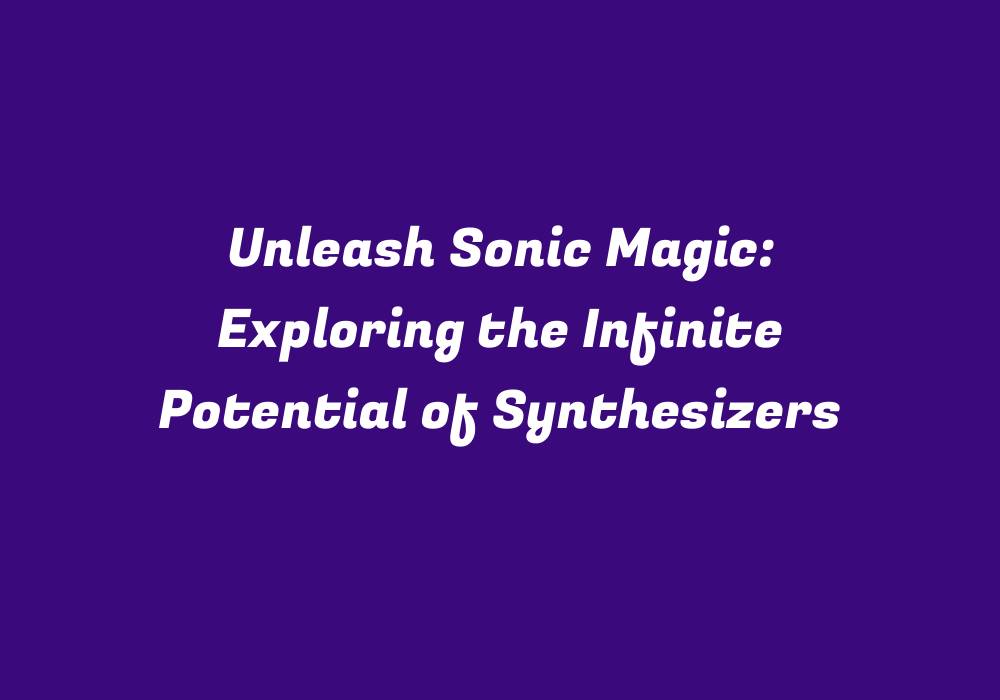Introduction
In our ever-evolving world of music production, one instrument has captivated the imaginations of sound engineers, musicians, and producers alike – the synthesizer. This revolutionary electronic musical instrument possesses infinite potential to create mesmerizing sounds and enchanting melodies. Unleashing its magic can transform a mere composition into a rich tapestry of sonic artistry. This article will delve into the fascinating world of synthesizers, exploring their history, types, and how they have shaped modern music.
History and Evolution
The journey of synthesizers began in the mid-20th century, with musicians seeking new ways to create unique sounds and push musical boundaries. The first electronic instrument that can be considered a predecessor was the Theremin, which was developed by Léon Theremin in 1928. While the Theremin was played without direct contact using two antennas, later inventions focused on creating keyboards or other interfaces for users to control sound generation more efficiently.
The development of analog synthesizers started in the 1960s when Moog Music introduced their first synthesizer, the Moog Modular System. This breakthrough instrument allowed musicians to create sounds by manipulating electronic oscillators, filters, and amplifiers. The 1970s saw an explosion in the popularity of synthesizers, with artists such as Kraftwerk, Tangerine Dream, and Jean-Michel Jarre using these devices to define their unique sound.
Digital technology revolutionized synthesizers during the 1980s and beyond, leading to more advanced features and affordable prices. The development of MIDI (Musical Instrument Digital Interface) in 1983 allowed synthesizers to be controlled by computers and other electronic musical devices. This further expanded their capabilities, as well as integrating them seamlessly with contemporary music production.
Types of Synthesizers
Synthesizers can be categorized into several types based on their sound generation methods, features, and functionality. Some common synthesizer types include:
1. Analog Synthesizers: As the name suggests, these instruments generate sounds using analog circuitry and electronic components, such as oscillators, filters, and amplifiers. The distinctive warmth and character of analog sounds have made them a popular choice for many musicians, even in digital age.
2. Digital Synthesizers: These instruments use computer-controlled technology to create sounds via digital signals. This offers greater control over the synthesis process, leading to more precise results when compared to their analog counterparts. Popular examples include Yamaha’s Motif series and Roland’s JP-8000/JP-8080.
3. Virtual Analog Synthesizers: These digital instruments mimic the behavior of analog circuitry, providing a hybrid approach that combines the best aspects of both analog and digital worlds. They often offer a wider range of features and sound manipulation capabilities compared to traditional analog synthesizers at more affordable prices.
4. Software Synthesizers: As an extension of virtual analog technology, software synthesizers run on computers and operate as VST (Virtual Studio Technology) or AU (Audio Units) plug-ins within digital audio workstations like Ableton Live, Logic Pro X, or FL Studio. These versatile tools offer a vast library of presets and customization options to create unique sounds in real-time.
5. Hardware Synthesizers: Designed to be used as standalone devices, these instruments are known for their tactile controls and intuitive user interface that makes sound creation more engaging and enjoyable. Examples include Korg’s Minilogue and Arturia’s MatrixBrute.
Applications in Modern Music Production
Synthesizers have found extensive application in various genres of modern music, from electronic dance music (EDM) to ambient, pop, and even film scores. The flexibility and versatility of these instruments allow composers to craft sonic landscapes tailored to their individual preferences and creative visions.
1. Electronic Dance Music: Synthesizers have become essential tools for producers in the EDM genre, enabling them to create intricate melodies, pulsating basslines, and captivating sound effects that drive the rhythm and energy of a track. From trance music’s atmospheric pads to hard-hitting dubstep basslines, synthesizers help bring these sounds to life.
2. Pop and Contemporary Music: In recent years, synthesizers have made significant inroads into mainstream pop and contemporary music. Artists like The Weeknd, Lady Gaga, and Taylor Swift often incorporate them into their songs to add depth and texture to the overall production, as well as create catchy hooks that make their music stand out.
3. Film Scores: Synthesizers have found their way into film scores thanks to their ability to create cinematic soundscapes and evoke a range of emotional responses from listeners. Their versatility allows composers like Hans Zimmer, John Williams, and Danny Elfman to create unique musical themes that reflect the mood and atmosphere of each film project they work on.
Conclusion
From their humble beginnings in the 1960s to their omnipresence in modern music production today, synthesizers have revolutionized sound creation and provided musicians with an infinite source of sonic magic. As technology continues to advance, the potential for innovation and artistic expression using these instruments will undoubtedly grow. The only limit is our imagination as we continue to explore this captivating world of synthetic sounds.
